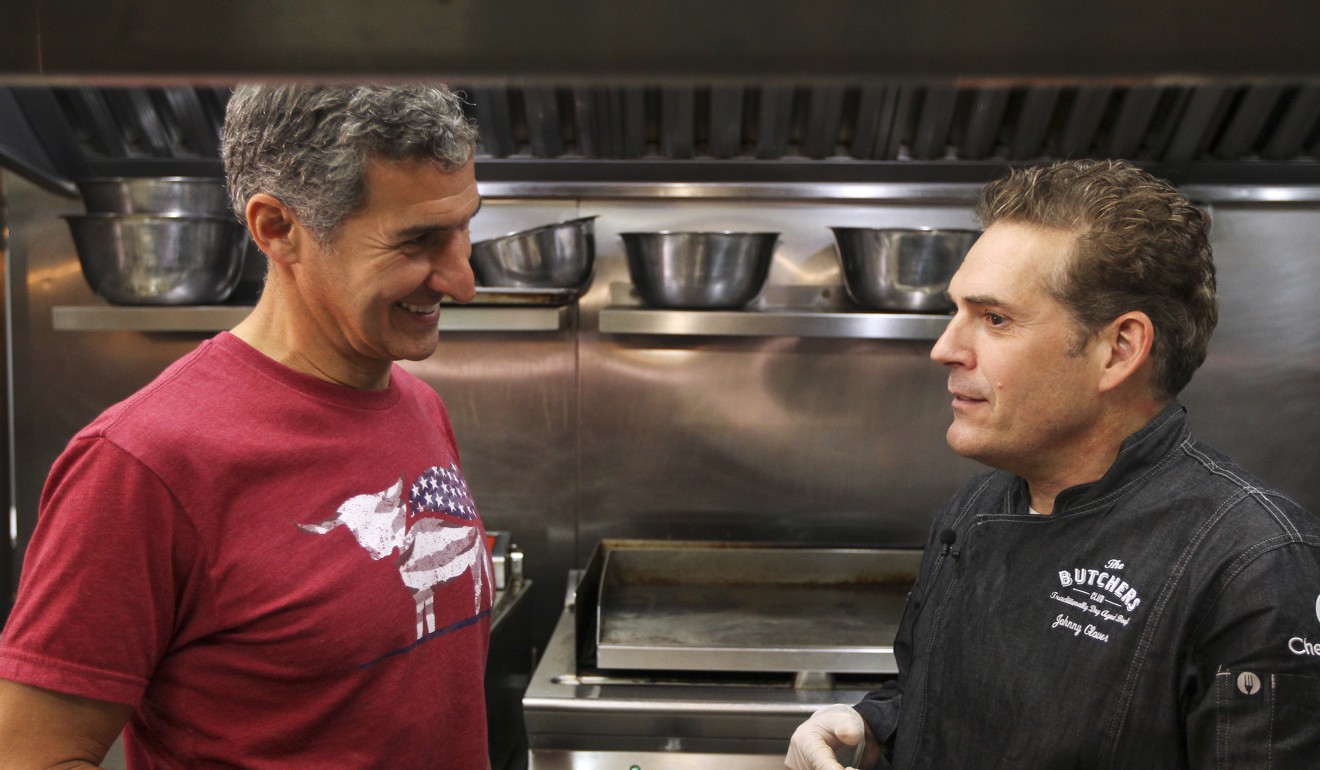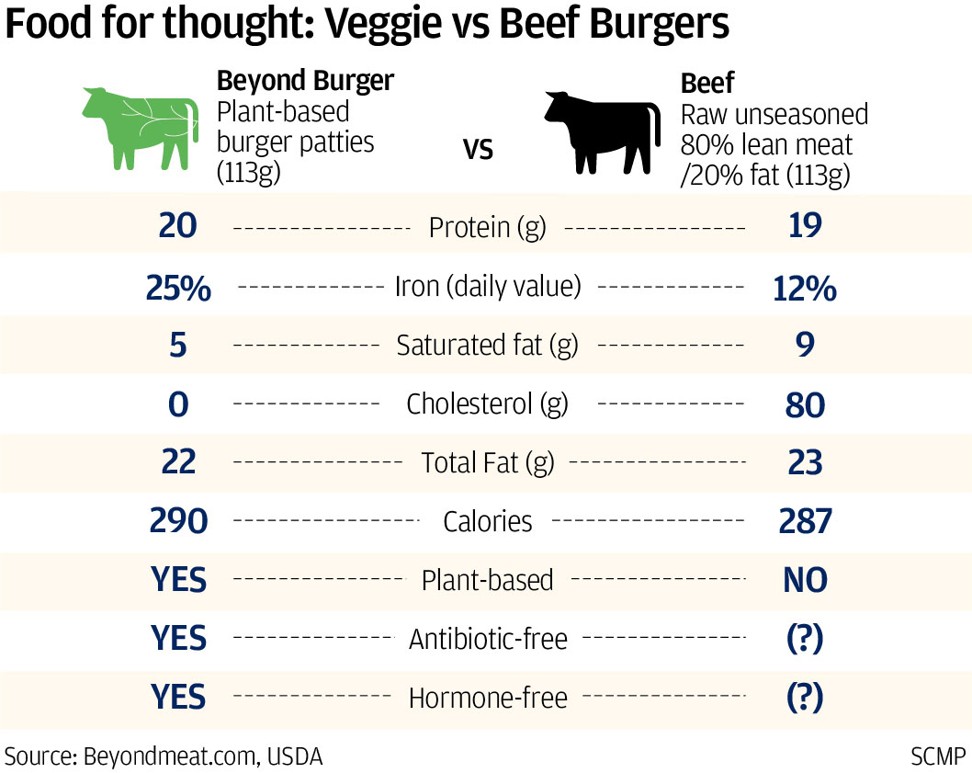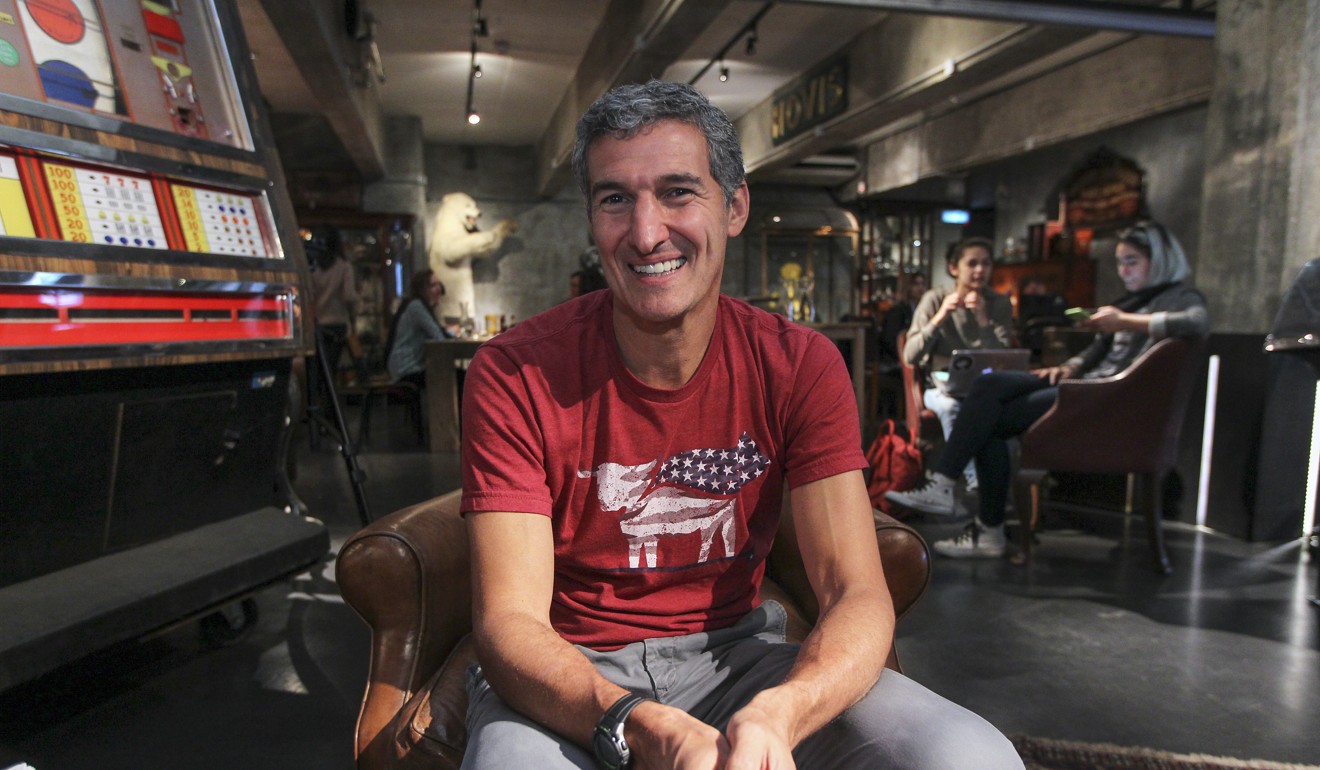
Hong Kong burger showdown: Beyond Meat’s vegan version vs Australian beef patty
Two burgers cooked in the same sauce, topped with sweet potato tempura and regular or vegan cheese, kimchi and mayonnaise – which one wins?
A showdown was happening at The Butchers Club Burger in Wong Chuk Hang. Two burgers looked exactly the same, but the key ingredients were vastly different. One featured a regular Australian beef patty cooked in Sriracha sauce, topped with cheddar cheese, kimchi, a sweet potato tempura slice and Kewpie mayonnaise.
The other had a vegan patty made from peas and other plants that was also fried in Sriracha sauce, but with dairy-free cheese, vegan kimchi (minus the fish sauce), the slice of sweet potato tempura, and egg-free mayonnaise. The buns for both burgers were vegan.
How vegan diet went from fringe to mainstream, and its advocates in Hong Kong and worldwide
Both were satisfying in different ways. The first had the meat taste in terms of richness and fattiness, while the other, a patty from Beyond Meat, had the texture of a meat patty, but was less filling and not as greasy.
The vegan burger in the taste test, Beyond Wu Tang-style, will be available at The Butchers Club Burger outlets from March 1 to April 30, and the chain’s founder, Jonathan Glover, is keen to add another plant-based option to his mostly meaty menu.
Sales of Beyond Classic, which features the same vegan burger patty with non-dairy cheddar, pickled beetroot chips, tomato, caramelised onions and vegan mayo, make up 10 per cent of the chain’s total sales. That echoes the experience of the Epic Burger chain in Chicago that started serving Beyond Meat’s patties last July.

“I’m surprised because the vegetarian burger is bringing in vegetarians and vegans who wouldn’t otherwise come to our restaurants,” Glover says. “We don’t have meat customers eating vegetarian burgers, but vegans and vegetarians coming in are a new market for us.”
A bump in customer base is what Seth Goldman, chairman of Beyond Meat, likes to see. He was recently in Hong Kongto visit the company’s only market outside the United States. That is because one of Beyond Meat’s more proactive shareholders is David Yeung, co-founder of Green Common, the vegetarian and vegan grocery store with seven locations in Hong Kong, including its latest branch opening at The Pulse in Repulse Bay.

Goldman says the sales of Beyond Meat in Hong Kong have grown fourfold in the past year, and he is looking at expanding to other markets.
“Meat is defined as protein from an animal. But when you analyse it, it’s really amino acids, lipids, water, some carbohydrates and minerals. We have created a product that mimics meat. We should separate the notion of meat and animal,” he says.
Inside Hong Kong’s growing appetite for veganism
Those who question how vegans get their protein may be surprised to learn that a 113-gram Beyond burger patty has slightly more protein than a same-sized beef burger, 20 grams versus 19 grams. While the calorie and total fat counts are nearly identical – 290 calories versus 287; 22 grams of fat versus 23 grams – the vegan patty has twice the daily recommended amount of iron, 25 per cent, versus the meat patty’s 12 per cent.
Beyond Meat is served in thousands of restaurants in the US, where the consumer is a “flexitarian” – or someone who is sometimes vegetarian. “Seventy per cent of consumers are flexitarian and they are the ones who are exciting,” Goldman says.
Having been in the food industry for more than 20 years, Goldman has seen two major trends in food. “First is that consumers are moving away from highly processed food. The other is they are moving towards re-doing of food, like re-doing dairy [such as having almond milk or oat milk]. It’s an exciting moment.”

Beyond Meat fits in the latter category, as peas, beetroot juice, coconut oil, non-GMO canola oil and bamboo fibre are mixed together so that the fats are broken up and connect with proteins. The process is called extrusion, where heat and pressure are used to bind the ingredients together to create a meat texture and taste, to make it more appealing to mainstream consumers looking for meatless options.
“We want the vegan and vegetarian to feel they can choose us, but if it means sacrificing that customer to be satisfying to 95 per cent of the population that isn’t vegan or vegetarian, that is the choice we’ll make,” Goldman says. “We’ll always choose the opportunity to bring this to scale versus making it relevant only to the purists. It may not be a diplomatic answer, but that is how we think about it.”
The nine best veggie burgers in Hong Kong, chosen by a meat-eater and a vegetarian
Beyond Meat was founded in 2009 by Ethan Brown, who questioned why protein had to come from meat. He felt raising livestock was an inefficient use of land, water and energy, since, in the end, only 30 per cent of the animal is used for food.
At that time he started working with two professors from the University of Missouri who were trying to develop a way to realign plant proteins into a meat texture. Beyond Meat has attracted funding from such investors as Bill Gates, The Obvious Corporation founded by Twitter co-founders Biz Stone and Evan Williams, and Honest Tea founder Seth Goldman.
We have created a product that mimics meat. We should separate the notion of meat and animal
Goldman got involved in Beyond Meat as an investor in 2012, then later as a board member and is now executive chairman, helping steer the company’s direction and growth. Beyond Meat has raised US$55 million and is now looking at expanding its markets beyond Hong Kong.
The company has other products, including Beyond Chicken Strips and Beyond Beef Crumble, but Goldman admits the burger patties are the bestsellers, making up more than half of total sales.
“They [chicken strips and crumble] work well, they taste good, but they’re not as close as the analogue. But from a consumer point of view, the burger is the only product an unsophisticated chef can cake home and have it work as well as a substitute,” he says.
The Beyond Burger also sizzles when put in a pan, “bleeds” thanks to beetroot juice, and can have char marks from a barbecue.
“We want vegans and vegetarians to choose us, but we want to go mass market,” he says, which explains why Beyond Meat agreed to accept funding from US multinational food corporation Tyson Foods, among the world’s largest processors and marketers of chicken, beef and pork.

“We’re the first plant-based meat burger that is sold in the meat section,” Goldman says.
Beyond Sausage was just launched a few months ago and uses an algae-based casing. He says the product may be in Hong Kong towards the end of this year.
Hong Kong Pig Save activists stage vigil at slaughterhouse to raise awareness of pigs’ plight
“It’s a neat moment where food is transforming and consumers get it, and they are seeking out [options], so the retailers and restaurateurs like Johnny [Glover] want to continue to be relevant,” Goldman says. “Consumers today have too much choice and power to be dictated to by big companies telling them what to buy, eat and wear.”

